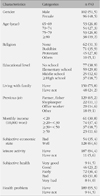Abstract
Purpose
The purposes of this study were to examine the relations among depression, life satisfaction and health promoting behavior, and to find factors related with health promoting behavior.
Methods
The subjects were 198 elderly people of over 65 living in K City and S City. Data were collected through a structured questionnaire and analyzed by SPSS/WIN 13.0.
Results
Health promoting behavior was significantly different according to religion, education level, living with family, previous job, pocket money, subjectively economic level, and leisure activities. Depression was significantly different according to education level, living with family, pocket money, economic level, and leisure activities. And life satisfaction was significantly different according to religion, living with family, and pocket money. The variables that affected the degree of health promoting behavior were depression, life satisfaction and living with family, and they represented 29.7% of health promoting behavior.
Conclusion
The health promoting behavior of the subjects was better than average and, at the same time, the lower depression in the health promoting behavior was the higher life satisfaction was. Therefore, in order to decrease depression and to increase life satisfaction, the development of advanced health promoting programs will be helpful to lead health life for the elderly people.
Figures and Tables
References
1. Choi YH, Kim YH. The study on health promoting lifestyle of the elderly. J Korean Soc Health Educ Promot. 2001; 18(3):103–115.
2. Demural S, Sato S. Relationships between depression, life style and quality of life in the community dwelling elderly: A comparison between gender and age groups. J Physiol Anthropol Appl Human Sci. 2003; 22(3):159–166.
3. Edelman CL, Mandel CL. Health promotion throughout the life span. 6th ed. New York: Elsevier Inc;2006.
4. Han MJ. The relationship study between sleep and cognitive function, depression of elderly women. Seoul: Ewha Womans University;2003. Unpublished doctoral dissertation.
5. Johnson F, Clotd C, Wer J. Life satisfaction of poorurban black aged. ANS Adv Nurs Sci. 1982; 4(3):27–34.
6. Jung YM, Kim JH. Comparison of cognitive levels, nutritional status, depression in the elderly according to living situations. J Korean Acad Nurs. 2004; 34(3):495–503.

7. Kang JS. The Factors which influence the depression of the elderly -Focused on the elderly person in the lower brackets of income-. Seoul: Choong-Ang University;2002. Unpublished master's thesis.
8. Kim HA. A study on health perception, health knowledge and health promoting behavior of the elderly. Seoul: Kyunghee University;2007. Unpublished master's thesis.
9. Kim HJ, Chae SO, Park YS, Woo SH. The relationship between perceived health status, health conception and health promoting behavior in the elderly. J Korea Community Health Nurs Acad Soc. 2001; 15(2):262–274.
10. Kim SH. Depression and health promoting behavior of elderly women in urban area. Daejeon: Chungnam National University;2006. Unpublished master's thesis.
11. Kim SY. A study of factors influencing health promotion behavior in elderly people: Self efficacy, social support and depression. J Korean Gerontol Nurs. 2003; 5(2):171–181.
12. Korea National Statistical Office. The elderly persons statistics. 2008. 10. 02. Retrieved April 25, 2009. from http://www.kostat.go.kr/board_notice/BoardAction.do?method=view&board_id=78&seq=574&num=574&parent_num=0&page=1&page_name=all_list&kind_id=2&catgrp=nso2009&catid1=k04___0000&catid2=k04b__0000&catid3=&catid4=.
13. Krishnan KR. Biological risk factors in late life depression. Biol Psychiatry. 2002; 52:185–192.

14. Lee SJ. An application effect of rhythmic movement program for the health promotion in the elderly. Seoul: KyungHee University;2000. Unpublished doctoral dissertation.
15. Lee YJ. The effects of lavender aromatherapy on sleep and depression of elderly. Daejon: Chungnam National University;2003.
16. Park CS. An analysis on the time-use the life satisfaction of the elderly people. J Korea Gerontol Soc. 1998; 18(3):30–46.
17. Park GJ, Lee JH, Bae KE, Kang YH, Song HS. Self-esteem and depression of elders in welfare facilities. J Korean Gerontol Nurs. 2007; 9(1):51–59.
18. Prohaska TR, Leventhal EA, Leventhal H, Keller ML. Health practice and illness cognition in young, middle aged and elderly adult. J Gerontol Nurs. 1985; 40(5):569–578.
19. Radecki SE. Health promotion for elderly patients. Fam Med. 1990; 22(4):299–302.
20. Roh KH. Effect of aroma leg massage on the depression and hope, stride length in the elderly. J Korea Gerontol Soc. 2004; 6(2):163–169.
21. Schank MJ, Lawrence DM. Young adult women: Lifestyle and health locus of control. J Adv Nurs. 1993; 18(8):1235–1240.

22. Song MS. Construction of a functional status prediction model for the elderly. Seoul: Seoul National University;1991. Unpublished doctoral dissertation.
23. Song MS, Song HJ, Mog JY. Community based cross-sectional study on the related factors with perceived health status among the elderly. J Korea Gerontol Soc. 2003; 23(4):127–142.
24. Suh YO. Hardiness and gender role characteristics in middle-aged women. J Korean Acad Womens Health Nurs. 1996; 2(1):119–134.
25. Walker SN, Sechrist KR, Pender NJ. The health-promotion life style profile: Development and psychometric characteristics. Nurs Res. 1987; 36(2):76–81.
26. Yohannes A, Connolly M. Gender differences in prevalence of depression in elderly patients with chronic obstructive pulmonary disease. Age Ageing. 2001; 30(4):74–76.
27. Yun J. A study of tool development for living satisfaction of elderly. Proceeding Book of Korean Psychiatric Academic Association. 1982. p. 26–30.




 ePub
ePub Citation
Citation Print
Print








 XML Download
XML Download